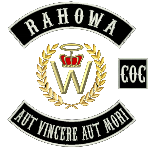- Welcome to Creator Forum - Racial Loyalty News Online.
• Shortened Link: W23.link » CreativityAlliance.com
• Beat the Censors on Social Media with ᵂ23 ᴰᴼᵀ ᴸᴵᴺᴷ
• Free @Rev.JoelDufresne P.O.W. USA - Prison Martyr - Bogus Charges
• Beat the Censors on Social Media with ᵂ23 ᴰᴼᵀ ᴸᴵᴺᴷ
• Free @Rev.JoelDufresne P.O.W. USA - Prison Martyr - Bogus Charges
-
 Digital ID Digital Money - China’s Social Credit System: A Dystopian...
by Rev.Cambeul
Digital ID Digital Money - China’s Social Credit System: A Dystopian...
by Rev.Cambeul
[Today at 2:15] -
 What is Creativity?
by Rev.JoelDufresne
What is Creativity?
by Rev.JoelDufresne
[Yesterday at 23:22] -
 Grandmother in hospital
by Rev.Cambeul
Grandmother in hospital
by Rev.Cambeul
[Yesterday at 22:18] -
 Br. Anthony S. - Prisoner of the J.O.G.
by Br.AnthonyS
Br. Anthony S. - Prisoner of the J.O.G.
by Br.AnthonyS
[Yesterday at 22:15] -
 This is Why We Hate Niggers!
by Br.IanVonTurpie
This is Why We Hate Niggers!
by Br.IanVonTurpie
[Yesterday at 19:36] -
 So What are the Third Worlders Gunna Do Here
by Br.IanVonTurpie
So What are the Third Worlders Gunna Do Here
by Br.IanVonTurpie
[Yesterday at 12:32] -
 When You Import the Third World
by Br.IanVonTurpie
When You Import the Third World
by Br.IanVonTurpie
[Yesterday at 12:31] -
 Now Playing: Music and Videos
by Br.IanVonTurpie
Now Playing: Music and Videos
by Br.IanVonTurpie
[Yesterday at 12:28] -
 Stinking Nigger Hides in the Trash
by Rev.Cambeul
Stinking Nigger Hides in the Trash
by Rev.Cambeul
[Yesterday at 8:22] -
 Rev. John Barletta - "Let the Beast Out"
by Rev.Cambeul
Rev. John Barletta - "Let the Beast Out"
by Rev.Cambeul
[Yesterday at 0:03] -
 Turd Worlder Craps in Melbourne Street
by Rev.Cambeul
Turd Worlder Craps in Melbourne Street
by Rev.Cambeul
[Wed 12 Nov 2025] -
 N.S. Network
by Br.IanVonTurpie
N.S. Network
by Br.IanVonTurpie
[Wed 12 Nov 2025] -
 Australian Native Mud Crime
by Br.IanVonTurpie
Australian Native Mud Crime
by Br.IanVonTurpie
[Wed 12 Nov 2025] -
 People Not Caring About Being Called “Racist”
by Br.IanVonTurpie
People Not Caring About Being Called “Racist”
by Br.IanVonTurpie
[Wed 12 Nov 2025]
Keep Creativity Online

Bitcoin/BTC Address:
3GyxbqYH3Hg6dpxVvS6PkFZ5FGbX1FLZ5N
Don't be a Jew - Donate Today

Bitcoin/BTC Address:
3GyxbqYH3Hg6dpxVvS6PkFZ5FGbX1FLZ5N
Don't be a Jew - Donate Today
User actions







